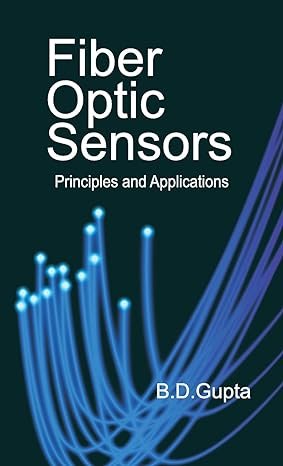
Fiber Optic Sensors
The book is an introduction to the rapidly emerging field of fiber optic sensors that is having significant impact upon areas such as guidance and control, structural monitoring, process control, biotechnology, geographical information systems and medicine.
Key Features
Provides the basic principles, applications and benefits of fiber optic sensor technology
Compressively describes different kinds of sensors and their applications.
Special stress and emphasis has been laid to present the information in an easy to understand language.
Provides the readers with about 210 figures and 150 equations
Explains the past, present and future of the fiber optic sensor technology.
A multi-purpose book beneficial for: postgraduate and Ph.D. students who would like to work in the field of fiber optic sensors. It will also provide extra knowledge to those who are doing courses on Optoelectronics and Fiber Optics, and above all to students, scientist and engineers in various physical, chemical and biological sciences
Preface
 The present book is an introduction to the rapidly emerging field of fiber optic sensors that is having significant impact upon areas such as guidance and control, structural monitoring, process control and medicine. The book will enable the reader to
The present book is an introduction to the rapidly emerging field of fiber optic sensors that is having significant impact upon areas such as guidance and control, structural monitoring, process control and medicine. The book will enable the reader to
– understand the benefits of fiber optic sensor technology
– know the basic principles upon which the fiber optic sensors rely
– become familiar with various physical, chemical and biological parameters that can be measured using fiber optic sensors
– understand how this technology is being used today and how it is likely to impact future systems and products.
The book is introductory and describes different kinds of sensors in a single book. The stress is on the principles and applications of various kinds of sensors. The book is intended for the postgraduate and Ph.D. students who would like to work in the field of fiber optic sensors. It will also provide extra knowledge to those who are doing courses on Optoelectronics and Fiber Optics. The scientists and engineers who are interested in learning about the operation and application of the fiber optic sensor technology will find this book very useful.
The first chapter of the book gives the introduction of the fiber optic sensors. The basic instrumentations required for fiber sensor are the optical fiber, light source and the detection system. In chapter 2 to 4, I describe briefly fiber optics, light sources and detectors respectively. Chapter 5 is devoted to the optical fiber sensors utilizing evanescent field absorption phenomenon. The sensors that do not require any reagent for absorption of light are discussed in this chapter. There are many chemical parameters that require the mediation of a reagent for their detection. Such kinds of sensors are described in chapter 6. The modulation of light in terms of intensity, phase, frequency, wavelength and polarization occurs in fiber optic sensors. Chapters 7 to 10 are devoted to fiber optic sensors based on wavelength, phase, polarization and
frequency modulation, respectively. In chapters 11 and 12, sensors utilizing most important fiber Bragg grating and surface plasmon resonance parameter as a function of position along the length of an optical fiber, and hence provides a unique capability to measure spatial variations of these quantities. Such systems are finding applications in industrial and environmental sensing. Chapter 13 is devoted to the distributed sensors. In the last chapter, simple, easy to make intensity modulated sensors have been described. The book should meet the requirements of students of science and engineering who are willing to work or are working in the area of fiber optic sensors.
I am grateful to my Teachers and Professor M.S. Sodha and Professor A.K. Ghatak who had encouraged me to work in the area of fiber optic sensors. Since the time I started work in the field of fiber optic sensors I had numerous stimulating discussions with my colleagues Professor B.P.Pal, Professor K.Thyagarajan, Professor Anurag Sharma, Professor Arun Kumar and Dr. M.R.Shenoy. I gratefully acknowledge them for these discussions. Writing a book in a short time was not possible without the help of many individuals. I am particularly grateful to my student Mr. Anuj Kumar Sharma for helping me in making figures and providing numerous suggestions towards the improvement of the book. My continuous interactions with my Ph.D. students have led to a deeper understanding of the field of fiber optic sensors. For this I would like to thank Dr. C.D.Singh, Dr. S.K.Khijwania, Dr. N.K.Sharma, Mr. to my wife Uma and my sons Amit and Puneet, for allowing me to spend lon
